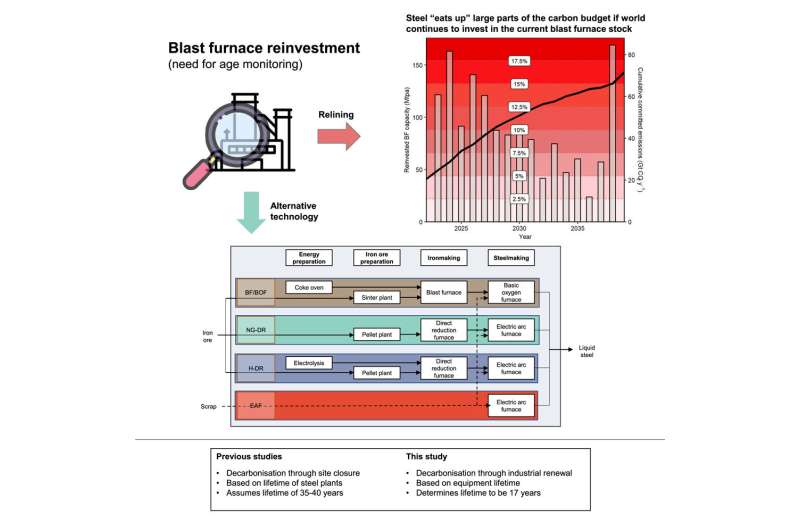Graphical abstract. Credit: DOI: 10.1016/j.joule.2021.09.007
The steel industry risks doubling its share of the global carbon budget if it fails to make multi-billion pound investments in emission limiting technology over the next five to 10 years, a new study led by a University of Sussex Business School academic warns.
Iron and steel production is the largest industrial emitter of CO2 and responsible for 7% of global greenhouse gas emissions. The researchers warn this could rise to 12% of the global carbon budget should the industry fail to promptly take up opportunities to upgrade existing facilities with net zero capabilities.
If the industry takes no action over the next five years to phase out carbon-intensive blast furnaces, the cumulative emission commitment from iron and steelmaking could double from current estimates to 40 Gt CO2eq warns the study led by Valentin Vogl from the Science Policy Research Unit (SPRU) at the University of Sussex Business School.
The research, which also includes academics from the Stockholm Environment Institute, finds that the emissions locked-in into the sector's future are up to two-thirds lower than previously feared which could allow for a low-carbon transition to happen sooner than previously predicted. But the authors add that this will only happen with rapid advancements in carbon capture or hydrogen steelmaking technology coupled with sufficient green hydrogen production.
The study authors warn that a major opportunity to limit emissions has already been missed as a huge number of steel mills built in China at the start of the century will undergo relining between 2021 and 2023 but offer hope that a binding global agreement by 2025 could help to avoid another round of reinvestments into blast furnace-based steel production around the world.
The researchers are calling on COP26 leaders to explore policy measures to phase out unmitigated blast furnaces and other Paris-incompatible industrial equipment as part of a broader decarbonisation policy mix that contains measures on market creation, subsidies, material efficiency improvements and a just transition for stakeholders.
The researchers highlight the need for:
- An observatory for emission-intensive industrial assets containing transparent data on emissions and asset age
- The imposition of legal restrictions on unabated iron and steel making assets
- Sharing technology for low-emission steelmaking internationally
The study, published today in the energy journal Joule, is the first of its kind to quantify the committed emissions from the industry based on actual historic operating patterns of steel production equipment. It includes data from 858 blast furnaces worldwide.
Valentin Vogl, from the Science Policy Research Unit (SPRU) at the University of Sussex Business School and Lund University, said: "The findings of our study are actually hopeful but with an important caveat. The world can move away from steel and it can do so quicker than previously thought. But it needs concerted action: deploying renewables, developing technology, reducing steel use, and making the transition just.
"Our study indicates that the technological carbon lock-in in the steel system is actually smaller than often assumed in past research. Future emissions from steel are driven not by long-lived capital, but by the deployment pace of novel technologies and renewable energy provision, and a reduction of steel and energy demand. Without rapid progress in these aspects, the operation of current steel production equipment is likely to consume significant amounts of the world's remaining carbon budget."
The study authors argue that blast furnace relining, the reoccurring investment where mill production is halted to allow for the repairing of refractory material that separates furnace walls from its hot contents, represents the best opportunity for steel producers to upgrade their facilities to low emission technology.
To decarbonise the steel sector, blast furnaces will have to equipped with capability for carbon capture and biomass fuel or be replaced in their entirety with a different technology such as the hydrogen direct reduction process, which in recent years has emerged as the industry's preferred decarbonisation route.
The researchers determined the median historic blast furnace campaign life to be 17 years, significantly lower than the lifetime assumptions made in previous studies of up to 40 years. The researchers found the median for first campaigns to be 19 years, falling to 16 years for the second campaign and 10.5 for the third.
Dr. Olle Olsson, Senior Research Fellow at the Stockholm Environment Institute, said: "While it is probable that decarbonisation of the global steel sector will entail the retirement of old steel plants and the establishing of new, greenfield steel mills, in the short-term the conversion of existing sites are likely to dominate. This is due to large sunk costs in downstream equipment and the presence of skilled and knowledgeable workers and staff as well as political interests in sustaining jobs and value creation locally.
"Our research reiterates the key point that retiring unmitigated blast furnaces does not have to be delayed until zero-emission technologies are fully commercialized. Intermediate steps that are aligned with a long-term zero emission strategy that limits further carbon lock-in can be implemented already today."
Dr. Björn Nykvist, Senior Research Fellow at the Stockholm Environment Institute, said: "The economic lifetimes of large assets are affected not least by political and economic conditions as well as public acceptance. This means that policy makers, market actors and civil society all have some power to accelerate the decarbonisation of the steel sector by tilting investment decisions from carbon-intensive towards low-carbon alternatives.
"Responding to this issue will require international cooperation because the benefits of retiring furnaces in one jurisdiction could be compromised by the building of new blast furnace equipment in others."
More information: Valentin Vogl et al, Phasing out the blast furnace to meet global climate targets, Joule (2021). DOI: 10.1016/j.joule.2021.09.007
Journal information: Joule
Provided by University of Sussex
























